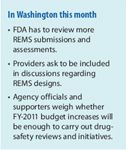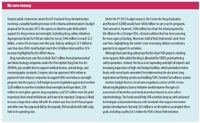Risks and Realities of REMS
FDA lacks resources to manage expanding postmarketing responsibilities.
It now appears that the US Food and Drug Administration wants a Risk Evaluation and Mitigation Strategy (REMS) for most new drug products, an approach that is having a noticeable impact on drug development and regulatory strategies. Manufacturers are confused about what information the agency wants, and when, and uncertain about how to devise and implement multiple REMS programs. In many cases, FDA requires manufacturers to issue only a Medication Guide for distribution to patients. All REMS carry timetables for periodic assessment, however, which is turning out to be a serious headache for the industry.

Jill Wechsler
Compounding the difficulties is a growing number of REMS for drug classes, which are more complex to establish and administer. In February, FDA finalized a REMS for erythropoiesis-stimulating agents (ESAs) used in cancer treatment, a process that took two years, and called for a class-wide REMS for long-acting asthma drugs. A broader REMS for ESAs in renal-disease treatment is in the works, and additional initiatives may be launched for antiseizure drugs and antidepressants, among other risky medicines. Negotiations continue for a multiproduct REMS for long-acting opioid drugs (see the July 2009 edition of this column in Pharmaceutical Technology for more information).

In Washington this month
A primary problem with these new REMS requirements is that FDA lacks the resources to review multiple REMS plans and their subsequent revisions. The agency also has to find time to develop policies for implementing postmarketing safety programs (see sidebar, "No new money") and to answer questions about how to comply with REMS procedures. FDA staffers are mulling over dozens of comments about a draft guidance on REMS format and assessment that was issued in September 2009. Pharmaceutical and biotechnology manufacturers have raised concerns about the program, as have pharmacists, health insurers, and payers who fear that too many REMS will impose added burdens and costs on the nation's healthcare system.

No new money
Assessments for already approved and high-risk drugs
At issue is the large number of REMS requested by FDA under the FDA Amendments Act of 2007 (FDAAA). The agency has approved some 100 new REMS since the program went into effect in March 2008. Most (71) call on manufacturers to provide only Medication Guides for pharmacists to give patients, but 23 also require communication plans that usually involve letters to healthcare providers informing them of safety issues.
In addition, FDA determined that 16 drugs from 24 sponsors that already had restrictive risk-management programs prior to the enactment of FDAAA were deemed to have REMS under the new policy. Those manufacturers, which include some generic-drug makers, had to submit REMS plans, but so far, FDA has approved only two of them.
FDA also has authority to determine whether a REMS is needed for other approved drugs based on the emergence of new safety information. To establish or revise a REMS for a marketed product, the manufacturer has to file a prior-approval efficacy supplement outlining its REMS plan. The drug can stay on the market during the months it takes FDA to approve such supplements, thus, creating a compliance quandary for manufacturers. Sponsors can update labels quickly by filing changes-being-effected supplements, but revisions to a REMS require prior approval. Thus, it's unclear whether manufacturers should change labeling immediately to reflect new safety issues, or wait for approval of revisions to a REMS.
Sponsors of the riskiest drugs have to establish REMS programs with Elements to Assure Safe Use (ETASU). In these instances, training and certification of health professionals may be required. In addition, FDAAA requirements call for limited distribution of the drug to certain healthcare settings, patient monitoring and testing, and enrollment of patients in registries for long-term evaluation. The need for later assessment may prompt manufacturers to compile databases of all certified prescribers and enrolled patients, monitor distribution and dispensing, and track duration of treatment.
In fact, all REMS programs, even those that only need Medication Guides, require periodic assessment to determine whether they are meeting goals. FDAAA stipulates that assessments must be conducted at least 18 months, three years, and seven years following market approval, but FDA may seek earlier assessment at six months or one year for particularly high-risk products. An assessment could indicate that the REMS program is no longer needed, but it's not clear what criteria would support such a conclusion.
It's important for manufacturers to fully define their REMS' goals in terms of specific measurable objectives, because failure to achieve those benchmarks could carry serious legal consequences. Manufacturers that fail to meet stated goals, whether for distributing Medication Guides or signing up prescribers for educational programs, could face stiff fines and penalties. The details regarding what manufacturers need to do to conduct an appropriate assessment, however, are not clear, points out attorney Howard Dorfman of Ropes and Gray in New York. "Will a pharma company be liable if CVS doesn't hand out MedGuides in a timely way?" he asked at a seminar on the REMS program in February sponsored by the Food and Drug Law Institute (FDLI).
REMS assessment is the hardest thing, said Wayne Pines of APCO Worldwide, a strategic communications firm, at the meeting. "Measuring the number of MedGuides handed out is easy; assessing the public-health impact is much more difficult."
At the same time, complying with REMS requirements could provide added protection for manufacturers against future product liability suits. A firm that meets all REMS requirements, along with other postmarketing policies established by FDAAA, may gain support for a preemption defense against lawsuits, Dorfman noted. Clear guidelines on what constitutes success in REMS implementation and in establishing sound pharmacovigilance programs would support that strategy.
Sooner or later?
FDA's proposed guidance doesn't answer all the questions related to REMS, but "it's a start," said Kathleen Frost, associate director for regulatory policy in the Office for Surveillance and Epidemiology (OSE) in FDA's Center for Drug Evaluation and Research (CDER). At the FDLI meeting, Frost was peppered with questions about when manufacturers should start discussing the need for a REMS with FDA and what kind of information the agency wants to see. Frost acknowledged that FDA examines whether a REMS is needed for every new drug application—even those that end up only with a Medication Guide or nothing—and that it can take time to determine whether the risks associated with a drug are fully characterized and what kind of intervention will help address those risks.
This expanded REMS-evaluation process has generated debate among regulatory experts, as well as FDA officials, about whether sponsors should hold off on submitting a proposed REMS until FDA asks for it, or take initiative and raise the issue before launching pivotal studies. Frost said it could benefit companies to lay out the reasons why a REMS is or is not warranted early in the process. But some lawyers advise manufacturers to avoid the issue if FDA doesn't bring it up.
The main risk for manufacturers is that if FDA staffers decide a drug needs a REMS after an application review has begun, the decision could lead to a Complete Response letter and put approval on hold for months. To avoid such delays, CDER efficacy review officials have been urging manufacturers to start discussing REMS issues as early as end of Phase II meetings to ensure that they collect necessary information on product risks and safety management during Phase III. These later studies may need to evaluate physician instructions for administering complex treatments, patient-monitoring procedures, ease in identifying side effects, impact of packaging on appropriate product use, and the effectiveness of educational materials.
But OSE officials say they lack the staff to address specific postmarket safety issues until a drug is much further along in the development process. OSE wants to be more involved in the early REMS- development process. But the safety office doesn't have the resources to step in at the end of Phase II if a REMS is just one line item on the meeting agenda, Frost explained.
In comments submitted to FDA regarding the draft REMS guidance, manufacturers urge early collaboration by CDER's new drug review and postmarketing safety offices. Industry also wants a standardized process for FDA review of REMS that would be linked to application-processing criteria established by the Prescription Drug User Fee Act (PDUFA). This topic already is on the agenda for the next round of negotiations on PDUFA, which are beginning this year in order to be in place by 2012. The PDUFA negotiations also are slated to raise the need for more resources to support drug-safety oversight, as well as alternative proposals to separate drug safety and efficacy review operations more clearly within FDA.
Pharmaceutical companies also would like FDA to be responsible for articulating the need for a REMS for drug products, instead of imposing that task on sponsors, as FDAAA currently requires. Manufacturers admit that they often are conflicted about whether a formal postmarketing safety system is warranted for a drug, whereas FDA reviewers have a clearer perspective on what kind of postmarket safety procedures are necessary and likely to benefit public health.
The role of generic-drug manufacturers in implementing REMS is another thorny topic. Generic-drug firms complain that brand companies are using complex REMS requirements to block the former's access to supplies needed to conduct bioequivalence studies, and that special distribution and patient monitoring programs raise the cost of entering a new market. The ESA REMS, for example, adds another hurdle for manufacturers contemplating follow-on biologic versions erythropoietin. Generic-drug makers also face challenges in using a single shared system to implement ETASU requirements such as provider certification and limited distribution, to keep the process manageable for providers.
Although the general thrust of the REMS policy is to increase the role of generic-drug manufacturers in ensuring the safe uses of marketed medicines, generic-drug firms get a break because FDA is charged with carrying out REMS communications plans when generic competition comes into play. The apparent aim is to avoid multiple versions of educational materials and information programs, but it could be difficult for FDA to carry out this mission. The agency won't have a big problem if most communication plans are limited to product launches or to the first few years a drug is on the market, as is usually the case. But too many long-term communications plans would impose a burden on FDA, Frost acknowledged, because the agency has limited resources to manage such programs.
Providers weigh in
Pharmacists and healthcare providers are concerned that too many diverse postmarketing drug safety programs will impose a burden on the healthcare system and patients as well, and that the requirements will drive up costs and limit access to therapies. Oncologists are upset that they were not consulted in developing the REMS for ESAs administered to cancer patients. Unlike the process being used to develop a classwide REMS for long-acting opioids, FDA negotiated the plan directly with Amgen (Thousand Oaks, CA) for Aranesp (darbepoetin) and Johnson & Johnson (New Brunswick, NJ), marketer of Procrit (epoetin). The American Society of Clinical Oncology notes that the REMS requires oncologists to enroll in pharmaceutical educational programs about the importance of limiting use of ESAs for cancer patients, a "duplicative requirement" that oncologists had no opportunity to help develop or review.
Kaiser Permanente, the California-based healthcare plan, similarly wants to have a seat at the table when FDA and drug companies design REMS to ensure they don't raise problems for healthcare providers and pharmacies. Requiring consumers to obtain medicines through select doctors and specialty pharmacies can increase costs for healthcare plans and consumers and may limit access to needed drugs. This concern raises questions about the overall benefits of the REMS program, Kaiser stated in a citizens' petition filed with FDA last year.
These issues have not been a problem so far because most REMS with ETASU have involved drugs for relatively small patient populations. But the prospect of mega-REMS for opioids and other drugs, says Kaiser, warrants regular review of such programs with FDA advisory committees to ensure a more transparent process. Kaiser also wants FDA to review and evaluate complex REMS programs at least annually, and to make these assessments public to help doctors and patients weigh treatment decisions.
Jill Wechsler is Pharmaceutical Technology's Washington editor, 7715 Rocton Ave., Chevy Chase, MD 20815, tel. 301.656.4634, jwechsler@advanstar.com.
